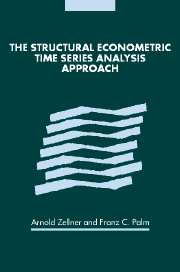Book contents
- Frontmatter
- Contents
- List of contributors
- Acknowledgments
- Introduction
- Part I The SEMTSA approach
- Part II Selected applications
- Part III Macroeconomic forecasting and modeling
- 13 Macroeconomic forecasting using pooled international data (1987)
- 14 Forecasting international growth rates using Bayesian shrinkage and other procedures (1989)
- 15 Turning points in economic time series, loss structures, and Bayesian forecasting (1990)
- 16 Forecasting turning points in international output growth rates using Bayesian exponentially weighted autoregression, time-varying parameter, and pooling techniques (1991)
- 17 Bayesian and non-Bayesian methods for combining models and forecasts with applications to forecasting international growth rates (1993)
- 18 Pooling in dynamic panel data models: an application to forecasting GDP growth rates (2000)
- 19 Forecasting turning points in countries' output growth rates: a response to Milton Friedman (1999)
- Part IV Disaggregation, forecasting, and modeling
- Subject index
- Author index
- References
19 - Forecasting turning points in countries' output growth rates: a response to Milton Friedman (1999)
Published online by Cambridge University Press: 24 October 2009
- Frontmatter
- Contents
- List of contributors
- Acknowledgments
- Introduction
- Part I The SEMTSA approach
- Part II Selected applications
- Part III Macroeconomic forecasting and modeling
- 13 Macroeconomic forecasting using pooled international data (1987)
- 14 Forecasting international growth rates using Bayesian shrinkage and other procedures (1989)
- 15 Turning points in economic time series, loss structures, and Bayesian forecasting (1990)
- 16 Forecasting turning points in international output growth rates using Bayesian exponentially weighted autoregression, time-varying parameter, and pooling techniques (1991)
- 17 Bayesian and non-Bayesian methods for combining models and forecasts with applications to forecasting international growth rates (1993)
- 18 Pooling in dynamic panel data models: an application to forecasting GDP growth rates (2000)
- 19 Forecasting turning points in countries' output growth rates: a response to Milton Friedman (1999)
- Part IV Disaggregation, forecasting, and modeling
- Subject index
- Author index
- References
Summary
In our past work (Zellner, Hong, and Min, 1991), we used variants of a simple autoregressive-leading indicator (ARLI) model and a Bayesian decision theoretic method to obtain correct forecasts in about 70 per cent of 158 turning point forecasts for eighteen industrialized countries' annual output growth rates during the period 1974–86. IMF data for 1951–73 were employed to estimate our models that were then employed to forecast downturns and upturns in annual growth rates for the period 1974–86. When Milton Friedman learned of our positive results, in a personal communication he challenged us to check our methods with an extended data set. This is indeed an important challenge since it is possible that we were just “lucky” in getting the positive results reported above. Earlier, we recognized such problems in that we began our forecasting experiments with just nine countries' data and forecasted for the period 1974–81. Later, in Zellner and Hong (1989) and in Zellner, Hong, and Min (1991), we expanded the number of countries from nine to eighteen and extended the forecast period to 1974–86 to check that the earlier positive results held up with an expanded sample of countries and data. Fortunately, results were positive and now we report such new results for eighteen countries' revised data involving 211 turning point episodes during the forecast period 1974–90.
- Type
- Chapter
- Information
- The Structural Econometric Time Series Analysis Approach , pp. 612 - 616Publisher: Cambridge University PressPrint publication year: 2004



